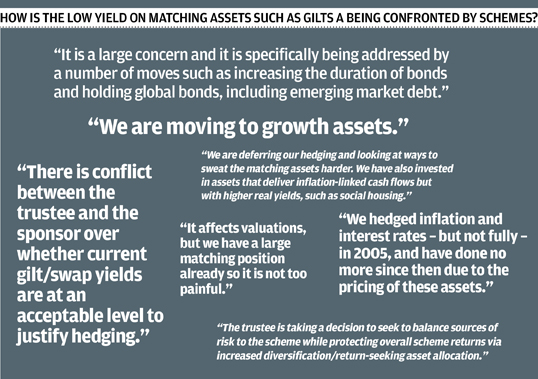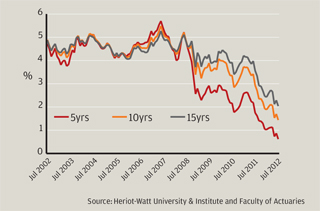Intelligent thinking: 'The most significant problem faced by pension funds'
Low yields from fixed income and the accompanying rise in asset valuations have forced pension funds and their advisers to seek alternatives, and potentially a higher level of risk. But does anyone have the answer?
Is there an answer to the problem of low gilt yields? Trustees, scheme managers and leading investment consultants were all asked the same questions on the thorny issue of fixed income. Here are their responses.
To what extent is the low yield on matching assets such as gilts a problem for you or your clients? How is this being confronted?
‘A challenge’, ‘a large concern’, ‘a significant problem’, ‘a big problem’, ‘a real problem’ and even ‘the most significant problem faced by pension funds’ – the way pension funds and their advisers describe historically low gilt yields match.
The low yields, of course, mean higher valuations of liabilities and they mean a big slug of assets that are struggling to make a real return.
Approaches to the problem are varied. The strength of sponsors and the maturity of schemes plays a part, while some of it is down to different beliefs about investing (approaches from scheme managers and trustees quoted opposite).
Needless to say, consultants do not have all the answers, though their responses are interesting. The most popular approach is to look to other bond-like assets instead.
Phil Edwards, a principal at Mercer, said: “Investors are starting to consider other asset-types that can generate liability-like cash flows, but where the valuation of these assets is not excessive, eg infrastructure or non-core property assets (such as ground leases or social housing).
Investment returns outside of equities look fairly appealing, so it’s important to take a holistic view of the scheme
“While these asset classes typically require investors to accept a material degree of illiquidity, they do offer the possibility of an inflation-linked income stream at a much more attractive yield than is currently on offer from government bonds.”
Consultants Redington have been at the forefront of promoting alternative sources of liability-matching assets and their head of manager research, Pete Drewienkiewicz, favours a dual approach with gilts.
“Investment returns outside of equities look fairly appealing, so it’s important to take a holistic view of the scheme – locking into real rates at 0 per cent may be the right thing to do if assets can be simultaneously invested to lock in Libor + 3 per cent across the portfolio,” he said. “It’s important not to let the low level of rates lead to ‘group-think’ that higher rates are inevitable, which they certainly are not.”
The use of derivatives is another option. Phil Page, client director at Cardano, said schemes that have historically hedged less, may be prepared to wait for better times to hedge, but that one way around this is to use swaption strategies to provide partial protection without giving up the benefit of rates rising.
For Crispin Lace, director of consulting at Russell Investments, the answer lies in the negotiation between the plan sponsor and the trustees.
“They need to decide whether they can afford to secure pensions at the current cost levels or whether they need to take additional risk to manage the costs. Most sponsors did not anticipate that the cost of the promised benefit would be as high as that implied by current yields.”
Lastly, for Phil Edwards of Mercer, it all comes down to risk appetites. “Investors with a low tolerance for funding risks might be willing to hedge their liability risks despite the low level of yields, while those with a greater appetite for risk may be willing to adopt a trigger-based approach that builds their exposure to bond assets only as yields rise,” he comments.
To what extent do you favour income or yield when picking investments?
The standard answer to this is that it depends on the maturity of the scheme and the extent to which near-term cash is needed to pay benefits. It relies on understanding the investments in the context of your scheme’s goals. For example, an investor with regular and significant cash outgoings may look to incorporate portfolios that offer a good level of income.
The distinction between immature and mature schemes was summed up by Lace at Russell Consulting.
He said: “For those clients who need capital preservation plus an income stream, income and yield are important considerations. For long-term investors with neutral or positive cash flows, the total return outlook becomes more important.”
Scheme responses
Given the preponderance of private sector schemes with mature liabilities taking part in the survey, there was a bias towards favouring income-generating assets in their responses.
Yield means nothing in the context of a deficit; income needs to meet the needs for reducing the deficit
“Currently, income is favourite.”
“In the current environment we would favour income in both bonds and equities.”
“Yield means nothing in the context of a deficit; income needs to meet the needs for reducing the deficit.”
“Total return is what matters.”
Though, there were dissenting voices. Nick Greenwood, pension fund manager at the £1.4bn Berkshire Pension Fund, said he thought the high dividend equity story had “run its course”.
There was little dissent from the consultants though. Edwards at Mercer said as pension schemes increasingly move into a cash flow negative position over time, income-generating assets may become a more important part of the portfolio mix. And the risk of focusing on yield alone was emphasised by Drewienkiewicz at Redington.
He said: “When yield is on offer but is extensively backloaded, it is important to assess the additional risks that come with that backloading and ensure they are being adequately compensated.”
Most Viewed
- What does Labour have in store for the pensions industry?
- LGPS latest: GLIL backers invest £475m for UK infrastructure push
- Dashboard costs rose by 23% in 2023, figures show
- Border to Coast launches UK strategy in major private markets push
- How the pensions industry can better support people with mental health problems



